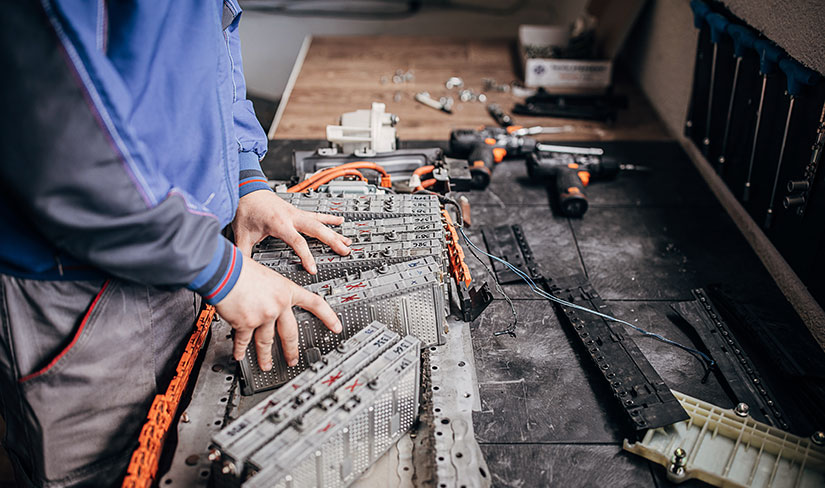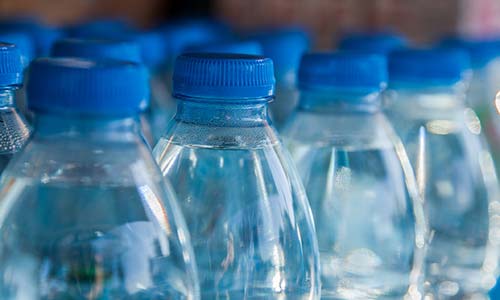Pathways To Achieve New Circular Vision for Lithium-Ion Batteries
NREL Study Analyzes Existing Policy and Regulations That Could Impact a Circular Economy for Lithium-Ion Battery Energy Storage Materials

Lithium-ion batteries are increasingly in demand for energy storage and use in electric vehicles—needs that are projected to grow further with expected technological innovations and declining costs.
Like most U.S. consumer products, the life cycle of lithium-ion batteries is based on a linear model in which batteries are made, consumed, and disposed of without much consideration for end-of-life management strategies, including opportunities to reuse or recycle. According to some estimates, waste from decommissioned electric vehicle lithium-ion batteries alone could total 4 million tons annually by 2040, or nearly the weight of 22,000 Boeing 747s.
A new vision is needed for the production, consumption, and retirement of lithium-ion batteries. To start to identify possible pathways for a circular economy—one of the laboratory's key research objectives—NREL analysts assessed the state of reuse and recycling of large-format lithium-ion batteries used in electric vehicles and battery energy storage through a literature review and interviews with battery energy storage experts.
Analysts found reusing and recycling lithium-ion batteries could create and expand U.S. market opportunities, stabilize the supply chain, reduce environmental impacts, and alleviate resource constraints. However, only one U.S. lithium-ion battery recycling facility exists today. The complete findings are published in an NREL technical report.
"A circular economy would extract more value out of battery energy storage systems," said project lead and NREL analyst Taylor Curtis. "The materials would be reused, recycled, or refurbished for multiple lifetimes rather than one lifetime that depletes finite resources and creates waste."
What Could Drive or Prevent a Lithium-Ion Battery Circular Economy?
Creating a circular economy for lithium-ion batteries could decrease manufacturing costs, add additional revenue streams, and offer tax benefits. New and expanded markets could also create jobs.
A circular economy could enhance market competitiveness by increasing a business's reputation and consumer trust through environmentally friendly practices. The broader environmental benefits could include reducing waste, energy usage, and greenhouse gas emissions, as well as preserving raw materials.
Such factors could drive U.S. federal, state, and local investment in a circular economy, as well private investment in product, service, and process innovation for the reuse and recovery of materials.
However, technology, infrastructure, and processes are current barriers. Variability in lithium-ion battery design and composition makes it difficult to design a standardized process to cost-effectively reuse or recover valuable materials, requiring costly manual processes.
In addition, there is limited reliable, publicly available information on the state or volume of retired lithium-ion batteries, or the cost to recondition them for other uses. The analysts recommend government-funded research, development, analysis, and incentives, as well as information exchanges, to increase knowledge and boost private investment.
What Regulations Apply to Reusing Lithium-Ion Batteries?
Regulations play a critical role in consumer product safety, reliable electricity service, and the safe handling, storage, treatment, reuse, recycling, and disposal of lithium-ion batteries. However, current regulations, codes, and standards for lithium-ion batteries are unclear, complex, and vary by jurisdiction.
Based on their findings, NREL analysts highlight existing regulations that could impact the installation and grid interconnection of repurposed lithium-ion batteries.
State and local regulations may govern 1) how battery energy storage systems connect to the electric grid, 2) the design, materials, and quality of buildings and structures that house or connect to the systems, 3) system electrical components for grid-tied applications, 4) and industry certification standards to determine the safety and reliability of the systems. These regulations could also impact secondary uses for lithium-ion batteries.
"Some states like California or New York are revising their regulations to ensure requirements for connecting to the grid specifically apply to battery energy storage systems," Curtis said. "This is a big development considering interconnection regulations were not developed with these types of systems in mind."
What Regulations Apply to Recycling Lithium-Ion Batteries?
Today, it is unclear how decommissioned lithium-ion batteries are legally defined in terms of waste. As of July 2020, no U.S. federal policies directly address battery energy storage system decommissioning, or mandate or incentivize reuse/recovery of lithium-ion batteries.
Decommissioned lithium-ion batteries are most often considered either hazardous or universal waste, which have their own regulations. Regulations also vary by jurisdiction, and non-compliance may result in fines.
Federal hazardous waste laws and regulations are the most stringent and govern the generation, handling, storage, treatment, domestic or international transport, and disposal of hazardous wastes. Lithium-ion batteries that are accumulated, stored, or treated before recycling could be subject to hazardous waste laws.
In some states, the penalties for violating hazardous waste laws or regulations are more stringent than federal penalties. For example, intentionally or negligently violating a provision of the state hazardous waste laws or regulations in California can result in a fine of up to $70,000 per violation for each day that the violation continues.
Clear and consistent federal, state, and local U.S. regulations related to recycling-based resource recovery of lithium-ion batteries could reduce regulatory uncertainty, liability concerns, and overall investor risk.
The U.S. Environmental Protection Agency has created alternative regulatory controls for recycling certain materials, like lead-acid batteries, to encourage the collection and recycling of hazardous waste. A similar designation for lithium-ion batteries could reduce liability concerns and make the economics of recycling more desirable.
The transition to a circular economy for energy materials will require widescale collaboration, new policy and business operations, and a systemic shift to benefit all stakeholders from consumers to manufacturers.
Last Updated May 28, 2025

